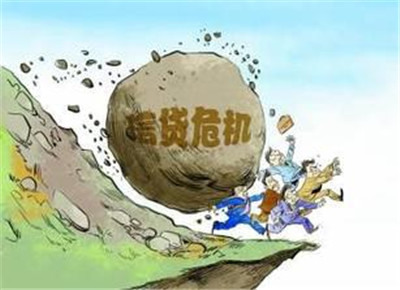(单词翻译:单击)
China has embarked on an economic balancing act that is bound to appear counter-intuitive to many observers. Trying to trim the country’s ballooning debt burden without sacrificing rapid growth sounds akin to keeping a horse running fast while feeding it less hay. There is always a danger that the horse may stumble and fall, causing the earth to shake.
中国已开始实施的经济平衡举措,在很多人的眼中肯定是有违常理的。试图在削减国内不断膨胀的债务负担的同时,又不牺牲快速的经济增长,这听起来就像是既要马儿跑得快、又要马儿少吃草。始终存在的一个危险是,这匹马儿或将踉踉跄跄地跌倒,震动整个大地。

Any sign of flagging economic dynamism in China will therefore be met with concern. Every year, the Chinese economy adds more to global output than any other. As a result, a flurry of less than vibrant economic statistics raises an insistent question: is China’s credit squeeze finally morphing into a credit crunch?
所以,只要有迹象显示中国经济活力不足,都会引发人们的担忧。中国经济每年对全球产出增长的贡献比其他任何国家都多。因此,一系列略显颓势的经济统计数据提出了一个迫切需要回答的问题:中国的信贷紧缩终于要演变为一场信贷危机了吗?
Deflation, as measured by the producer price index (PPI), deepened to -4.6 per cent in April. Industrial profits fell 2.7 per cent in the first quarter and land sales, a key source of revenue for cash-strapped local governments, by almost a third year on year.
4月份,衡量通缩的生产者价格指数(PPI)同比下降了4.6%,降幅较之前有所加大。今年第一季度,工业利润下降了2.7%,而卖地收入——资金短缺的地方政府的一项主要收入来源——同比下降了近三分之一。
The main concern is that falling industrial profits could render companies less able to service their huge debts, prompting them to call off or postpone investment plans and driving an upsurge in non-performing loans that would dissuade banks from lending. Indeed, fixed-asset investment growth is already declining significantly: falling to 12 per cent in the January to April period.
主要问题在于,工业利润下滑可能致使企业偿还巨额债务的能力降低,促使它们取消或推迟投资计划,并导致不良贷款激增、打击银行放贷兴趣。事实上,固定资产投资增长已在大幅下滑:今年头四个月里已下降了12%。
Such strains are exacerbated by another factor. Although Beijing has loosened monetary policy three times over the past six months, real interest rates are rising sharply as deflation bites. They climbed to 10.8 per cent in March, their highest level since the financial crisis. Nominal average lending rates are lower, at 6.6 per cent, but still anomalously high in a world in which some $2tn in bonds trade at negative yields.
另一因素进一步加重了这些压力。虽然过去6个月中国政府已经三次放松货币政策,但随着通缩开始显现出威力,实际利率正在大幅攀升。3月份,实际利率已升至10.8%,为本次金融危机以来的最高水平。名义平均贷款利率相对较低,为6.6%,但在世界上约2万亿美元债券的收益率为负时,这一利率仍显得高得出奇。
The impact of such a tight credit environment becomes clear when the size of China’s total corporate debt service burden is calculated. Given that non-financial total corporate debt is estimated by McKinsey to amount to $12.5tn, Chinese companies are paying on a nominal basis some $812bn in interest payments each year. In real terms, this amounts to $1.35tn. This is not only significantly more than China’s projected total industrial profits this year; it is slightly bigger than the size of a large emerging economy such as Mexico.
若将中国企业总偿债负担的规模考虑进来,这种紧缩信贷环境的影响就变得清晰起来。根据麦肯锡(McKinsey)估计,中国的非金融企业债总额为12.5万亿美元,因此中国企业每年偿付的名义债息约为8120亿美元。若按实际利率计算,债息则为1.35万亿美元。这不仅远远大于今年中国工业利润总额的预期值,而且还略大于墨西哥等大型新兴经济体的产出规模。
Beijing has several policy options at its disposal to keep a full-blown credit crunch at bay. Most analysts expect China to keep cutting interest rates while seeking to alleviate deflation by kick-starting infrastructure projects and invigorating the property sector. There are signs that such efforts are starting to bear fruit.
中国政府要想避免爆发全面信贷危机,有几个政策选项可供选择。多数分析师预计,中国将继续降低利率,同时通过启动基建项目和刺激房地产业来缓解通缩。有迹象表明,这些努力正开始奏效。
A more long-term approach involves relieving the debt mountains that have piled up on the books of local governments, which are the main agents of infrastructure investments. In March, the finance ministry said it would allow local governments to refinance Rmb1tn in off-balance-sheet debt as official government debt by selling bonds to state banks. Banks initially gave the plan a less than enthusiastic reception, but Beijing has reinforced its support by ordering that banks keep up lending to infrastructure projects that are ongoing.
更长远的对策包括减少地方政府账面上堆积的巨额债务,地方政府是基础设施投资的主体。3月份,中国财政部表示,将允许地方政府以向国有银行发债的方式将1万亿元人民币表外债务置换为正式的政府债务。起初,银行对这一计划并不热情,但北京方面以命令银行继续向进行当中的基建项目发放贷款的方式,强化了对该计划的支持。
The situation that China faces is an unenviable one. But amid all the pressure, Beijing’s policy makers are adopting the right priorities. Forced to choose between deleveraging and maintaining a rapid clip of gross domestic product growth, they have opted for the latter. A credit crunch would risk an economic crisis from which it might take years to recover.
中国当前面临的形势是不值得羡慕的。但在众压之下,北京的政策制定者遵从了正确的政策优先次序。当不得不在去杠杆化与保持国内生产总值(GDP)快速增长之间做出选择时,他们选择了后者。信贷危机可能导致经济危机,而一旦发生经济危机,中国可能要花数年时间才能复苏。


